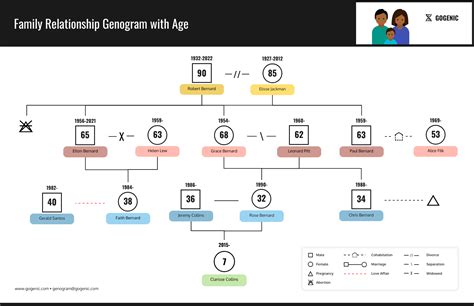The concept of Three-Gen planning has emerged as a pivotal strategy in contemporary business and organizational development, focusing on the integration of three generations in the workforce: Traditionalists, Baby Boomers, and Generation X, along with the newer generations such as Millennials and Gen Z. This approach recognizes the diverse strengths, weaknesses, and values that each generation brings to the table, aiming to leverage these differences to enhance organizational performance, innovation, and succession planning. By understanding and capitalizing on the intergenerational dynamics, companies can foster a more inclusive, adaptable, and resilient work environment.
Understanding the Generations

At the heart of Three-Gen planning is the comprehension of the distinct characteristics of each generation. Traditionalists, born between 1922 and 1945, are known for their loyalty, discipline, and adherence to traditional values. Baby Boomers, born from 1946 to 1964, are characterized by their strong work ethic, loyalty to their employers, and a tendency to define themselves by their professional roles. Generation X, born between 1965 and 1980, values work-life balance, is tech-savvy, and prefers a more autonomous work style. Millennials, born from 1981 to 1996, are digital natives, prioritize flexibility and feedback, and are known for their entrepreneurial spirit. Lastly, Gen Z, born from 1997 onwards, is marked by its pragmatism, diversity, and a strong affinity for technology and sustainability.
Intergenerational Collaboration
Effective Three-Gen planning involves facilitating collaboration among these diverse age groups. This can be achieved through mentorship programs where older generations can share their experience and knowledge with younger colleagues, who in turn can introduce them to new technologies and innovative thinking. Cross-functional teams that include members from different generations can tackle complex projects, leveraging the varied perspectives and skill sets. Furthermore, flexible work arrangements that cater to the different needs and preferences of each generation can enhance job satisfaction and productivity.
| Generation | Birth Years | Key Characteristics |
|---|---|---|
| Traditionalists | 1922-1945 | Loyalty, Discipline, Traditional Values |
| Baby Boomers | 1946-1964 | Strong Work Ethic, Loyalty, Professional Role Definition |
| Generation X | 1965-1980 | Work-Life Balance, Tech-Savviness, Autonomy |
| Millennials | 1981-1996 | Digital Nativeness, Flexibility, Entrepreneurial Spirit |
| Gen Z | 1997 and later | Pragmatism, Diversity, Affinity for Technology and Sustainability |

Key Points
- Understanding the distinct characteristics of each generation is crucial for effective Three-Gen planning.
- Mentorship programs and cross-functional teams can facilitate intergenerational collaboration and knowledge transfer.
- Flexible work arrangements can cater to the diverse needs and preferences of a multigenerational workforce.
- Capitalizing on the strengths of each generation can enhance organizational innovation, performance, and succession planning.
- A culture of mutual respect, open communication, and collaborative problem-solving is essential for unlocking the potential of a multigenerational workforce.
Implementing Three-Gen Planning

The implementation of Three-Gen planning involves several strategic steps. First, organizations must conduct a thorough analysis of their current workforce demographics and identify areas where intergenerational collaboration can be enhanced. This may involve training programs to address potential generational biases and improve communication skills. Second, companies should develop and promote flexible work policies that accommodate the different needs of each generation, such as remote work options for Millennials and Gen Z, or phased retirement plans for Traditionalists and Baby Boomers. Third, organizations must prioritize succession planning, ensuring that knowledge and skills are transferred from one generation to the next through systematic mentorship and training initiatives.
Challenges and Opportunities
Despite its benefits, Three-Gen planning also presents several challenges. One of the primary obstacles is managing the different expectations and values of each generation. For instance, Millennials and Gen Z may prioritize work-life balance and continuous feedback, while Traditionalists and Baby Boomers may emphasize loyalty and traditional hierarchies. Additionally, the integration of new technologies and the adaptation to changing market conditions can be daunting for some generations. However, these challenges also present opportunities for growth and innovation. By embracing the diversity of their workforce, organizations can foster a culture of creativity, resilience, and continuous learning.
What are the primary benefits of implementing Three-Gen planning in an organization?
+The primary benefits include enhanced organizational performance, improved innovation, and effective succession planning by leveraging the diverse strengths and experiences of a multigenerational workforce.
How can organizations facilitate intergenerational collaboration and knowledge transfer?
+Through mentorship programs, cross-functional teams, and flexible work arrangements that cater to the different needs and preferences of each generation, facilitating an environment of mutual respect and open communication.
What role does technology play in Three-Gen planning?
+Technology plays a crucial role in facilitating communication, collaboration, and knowledge transfer among different generations. It also enables flexible work arrangements and can help bridge the gap between the tech-savviness of younger generations and the experience of older generations.
In conclusion, Three-Gen planning is a forward-thinking approach that recognizes the value of diversity in the workplace, particularly across different generations. By embracing this strategy, organizations can not only improve their current performance but also ensure their long-term viability and competitiveness in a rapidly changing world. As the workforce continues to evolve, the ability to adapt and integrate the strengths of each generation will be a key differentiator between successful and struggling organizations.



